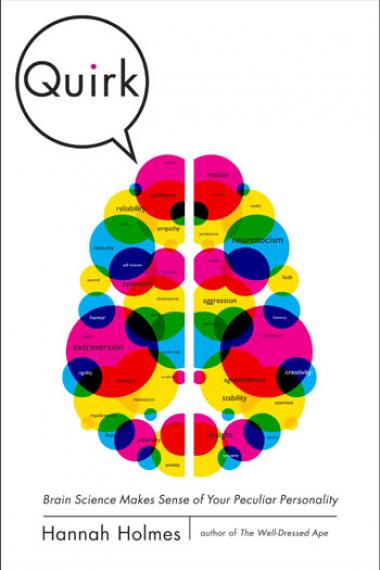What makes us who we are? The question has captivated philosophers and scientists for millennia, from the ancient Greeks and their humors to the 19th-century phrenologists who believed they could divine someone’s personality by mapping the bumps on his skull. The personality question captivates us still, though the answers have gotten more complicated—and microscopic. But fret not: To help navigate the modern maze of neurotransmitters, animal models, and evolutionary theory, we have science writer Hannah Holmes and her book Quirk.
Today, many psychologists divide our temperaments into a handful of major components known as “The Big Five”: neuroticism, extraversion, agreeableness, conscientiousness, and openness. Each of these factors gets further broken down into six facets—agreeableness, for instance, includes the facets of trust, cooperation, and altruism. How people score on each of these and other dimensions can provide snapshots of their unique personalities.
Holmes devotes each chapter to a single facet (she covers 18 in all), using the same formula to explore each trait. She begins with a peek into a lab where rodents are bred to exhibit one particular facet. In the anxiety chapter, for example, we meet the Nervous Nellies, mice that cower in the dark corners of elevated mazes, afraid to venture into the open. Such animal subjects are helping researchers unpack the biological underpinnings of personality. Want to create one of these fretful rodents? Disrupt a gene that regulates serotonin, a neurotransmitter that’s also been implicated in depression.
Then Holmes shows that the same chemicals and genes influence human personalities. Study a group of anxious female college students, and you’ll find that they, too, have genetic variants that alter the way their brains process serotonin. Finally, Holmes explores why such diversity of personality exists in the first place. “Why,” she asks, “would evolution produce animals that appear to be overly fearful, and overly bold?”
Biologists have long known that, from an evolutionary point of view, a diverse population is a healthy one. A species that includes creatures of all shapes, sizes, and talents is more likely to have some individuals that can survive whatever challenge the world throws at them.
It’s not a new idea, but it’s interesting to consider in relation to personality. Let’s look again at anxiety. When food was scarce, brave animals willing to travel to fill their bellies would have had an obvious evolutionary advantage. But venturing away from home comes with risks—of becoming lunch for other critters, say, or suffering a grievous injury. So when food was plentiful and easy to find, the nervous homebodies would be more likely to survive and pass on their high-anxiety genes.
Holmes has a gift for making complex science clear and accessible, but Quirk has one flaw: It exhibits more than a whiff of biological determinism. Consider the discussion of altruism. Researchers have found that a neurotransmitter known as vasopressin is connected to altruism. The gene responsible for the vasopressin system comes in two forms—a short gene, which leads to less vasopressin, and a long gene, which leads to more of it. On average, Holmes writes, “people with two copies of the short version of the vasopressin gene give the least; those with one long and one short copy are middling; fools who give the shirt off their back are most likely to have two copies of the long version. Vasopressin and altruistic behavior look as though they’re bound in holy matrimony. Or in biological matrimony, at any rate.”
The genetic effect on altruism is indeed remarkable, but DNA is not the end of the story. To assess generosity, scientists often use a game in which players are given a small amount of cash and asked to decide how much to contribute to a common pool of money. Noting, for example, that subjects from cultures in which offering charity is insulting tend to give little, Holmes concedes culture’s influence on this experiment.
It’s an observation that warrants more than a couple of sentences in a chapter chock-full of molecular biology. Even if Holmes wanted to maintain her rigid focus on genes and neurotransmitters, it would have been worthwhile to remind readers that brains and genes are just part of the puzzle. With personality, as with most human traits, it’s nature and nurture. Holmes’s book, interesting as it is, addresses only half of the equation.

